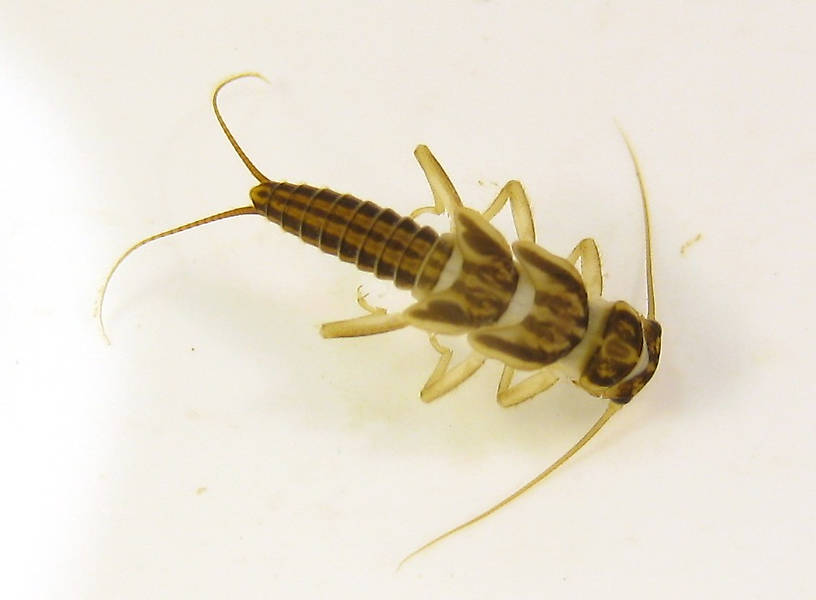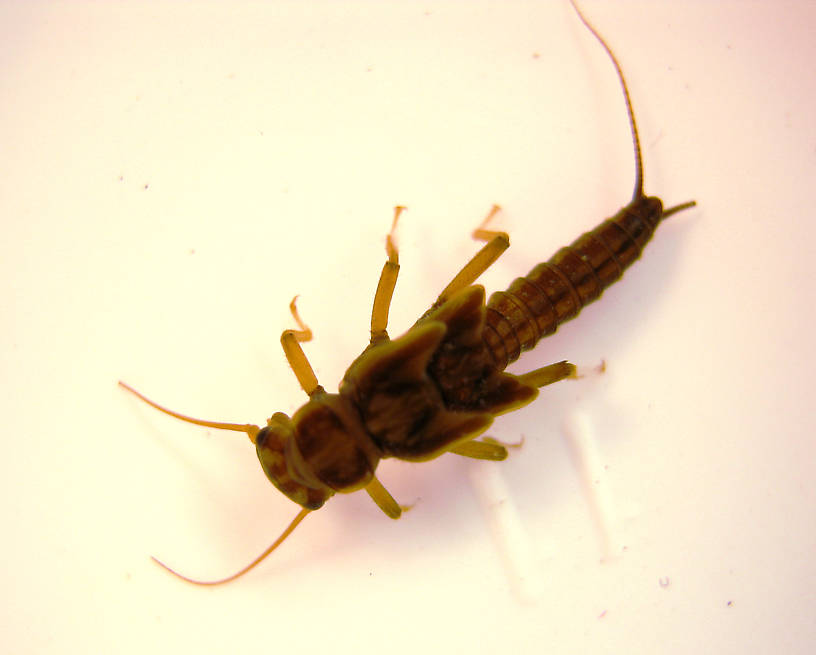
Hex Mayflies
Hexagenia limbata
The famous nocturnal Hex hatch of the Midwest (and a few other lucky locations) stirs to the surface mythically large brown trout that only touch streamers for the rest of the year.

Stonefly Species Isoperla quinquepunctata (Little Yellow Stoneflies)
Where & when
Time of year : Early spring through late Summer depending on elevation
Preferred waters: Riffles and runs over cobble
In 23 records from GBIF, adults of this species have been collected during June (48%), July (43%), and May (9%).
In 4 records from GBIF, this species has been collected at elevations of 4403, 7920, 8760, and 8862 ft.
Species Range
Identification
Species ID from GBIFthe Global Biodiversity Information Facility
Source: The Isoperla Of California (Plecoptera: Perlodidae); Larval Descriptions And A Key To 17 Western Nearctic Species
Diagnosis. Mature male Isoperla quinquepunctata larval pigment patterns are most similar to Isoperla acula, Isoperla mormona and Isoperla sordida (Figs. 3 a-d, 12 a-d, 15 a-d, 18 a- d). In California, this species can be differentiated from other species with 1 – 4 submarginal setae (A + B) by having 48 – 97 ventral surface (D) setae (Figs. 15 eh), pronotal discs patterned with small to large central light areas, when large these areas not completely enclosed by dark pigment (Fig. 15 b).
Physical description
Most physical descriptions on Troutnut are direct or slightly edited quotes from the original scientific sources describing or updating the species, although there may be errors in copying them to this website. Such descriptions aren't always definitive, because species often turn out to be more variable than the original describers observed. In some cases, only a single specimen was described! However, they are useful starting points.
Description from GBIFthe Global Biodiversity Information Facility
Source: The Isoperla Of California (Plecoptera: Perlodidae); Larval Descriptions And A Key To 17 Western Nearctic Species
Male larva. Body length of mature larva 9 – 12 mm. Dorsum of head with contrasting pigment pattern and a mixture of fine light and dark clothing setae, anterior frontoclypeus margin unpigmented; light M shaped pattern anterior to median ocellus usually indistinct, not connected to light frontoclypeus area, median light longitudinal light band absent, lateral thin arms faint, directed posterolaterally, extending to antennal bases; posterior ocelli with partially enclosed large light areas along outer lateral margins; interocellar area partially light and variable, either completely enclosed by dark pigment and entirely within the triangle, enclosed by dark pigment and extended posteromedially past posterior ocelli, or connected to posterior margin of head by thin longitudinal light pigment band; occiput with irregular spinulae band extending from below eye to near median epicranial suture, not enclosed completely by dark pigment (Fig. 15 a). Lacinia bidentate, total length 696 – 828 µm (Figs. 2 m, 15 e- h, Tables 2 - 4); submarginal row (A + B) with 3 – 4 setae, groups A-B interrupted by gap below subapical tooth (SAT) inner margin (Figs. 15 g-h); 1 submarginal seta (A) inserted at the base apical tooth (AT) inner margin, plus 1 thin marginal seta (TMS) adjacent to AT inner margin, sometimes obstructed from view by AT or broken, and 1 dorsal seta (DS) located below SAT inner margin, partially obstructed by SAT (Figs. 15 g-h); 2 – 3 submarginal setae (B) located past SAT inner margin (Fig. 15 h); 7 – 11 marginal setae (C), initially long-stout and widely spaced, last few shorter and widely spaced, blending into and difficult to differentiate from dorsal and ventral surface setae (Fig. 15 e); 48 – 97 ventral surface setae (D) forming dense longitudinal band below submarginal and marginal setae, ending posteriorly at approximately ¾ the inner lacinia margin length, setae closest to inner margin protrude laterally past lacinia margin (Fig. 15 f); dorsal surface setae (DSS) forming dense, laterally protruding, longitudinal band on and along inner-lateral margin, ending before posterior-most ventral surface setae (Fig. 15 f). Galea with 23 – 27 setae in sparse ventral row, apex with 5 setae. Maxillary Palp segments 2 – 3 with curved, apically pointed setae. Pronotum with median light area occasionally with a short central indistinct brown band bordered by irregular dark pigment markings; discs each with partially to completely enclosed light areas, the largest resembling the “ windows ” described for Isoperla acula, fine dark clothing setae and lateral margins with broad light bands (Fig. 15 b). Mesonotum and metanotum with contrasting pigment pattern and fine light and dark clothing setae, dark setae enclosed by dark pigment (Fig. 15 c). Legs with numerous fine light clothing setae and scattered erect spines on outer surface of femora, erect spines longest and concentrated on dorsal surfaces; fine silky setae numerous and continuous on dorsal surfaces of femora and tibia (Fig. 20 m); tibia with at most, a very faint and incomplete band near joint with femora; femora with median, longitudinal light brown pigment band concentrated distally. Abdominal terga with three distinct longitudinal dark stripes; wide light median longitudinal band bisected with variable, thin to thick, dark median longitudinal stripe; lateral pair of dark longitudinal stripes about twice as wide as median dark stripe, nearly extending to lateral margins; numerous fine dark clothing setae and erect spines scattered dorsally; posterior margin with scattered long and numerous short spines in a concentrated row (Fig. 15 d).
Source: The Isoperla Of California (Plecoptera: Perlodidae); Updated Male Descriptions And Adult Keys For 18 Western Nearctic Species
Male. Aedeagus: sclerotized posterior process absent; body of aedeagus with a small posteromedian lobe covered with minute spinulae, one posteroapical lobe, one dorsal lobe, and an anterior lobe (Fig. 12 a). Posterolateral margin of ninth and tenth terga with patches of long stout setae, fewer and smaller on tergum ten (Fig. 12 c). Posterolateral margins of at least abdominal segment 8 with scale-like setae clustered in brushes of several setae. Paraprocts: curved dorsally, length if straightened subequal to combined first and second cercal segments, tapering gradually to blunt apices (Fig. 12 c). Vesicle: rounded lobe, widest at base with broadly rounded apical margin (Fig. 12 d), sometimes appears constricted along inner sclerotized lateral margins with wider and broadly rounded membranous outer lateral margins.
Specimens of the Stonefly Species Isoperla quinquepunctata
2 Nymphs
Start a Discussion of Isoperla quinquepunctata
Stonefly Species Isoperla quinquepunctata (Little Yellow Stoneflies)
Species Range
Common Names
Resources
- NatureServe
- Integrated Taxonomic Information System
- Global Biodiversity Information Facility
- Described by Banks, N. (1902) Notes and Descriptions of Perlidae. The Canadian Entomologist 34, 123–125.




